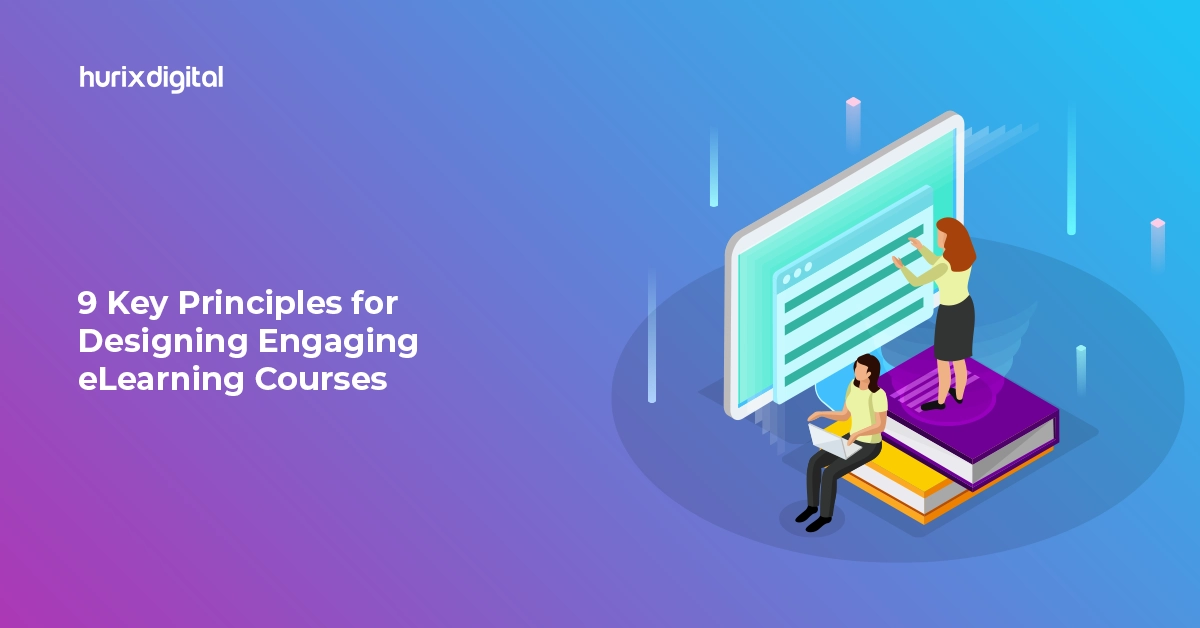
9 Key Principles for Designing Engaging eLearning Courses
Summary
This blog discusses the principles and advantages of creating engaging eLearning courses across domains, emphasizing design importance and summarizing key points.
Creating engaging eLearning experiences that establish a connection between your course plan and your learners makes learning easy, intuitive, and simple.
While 94% of workers say they are prepared to stick with a company that makes investments in their training and development, the workforce eLearning market is projected to grow by $38.09 billion. Amidst the rising demand for engaging eLearning courses, establishing a robust course design is a cornerstone.
This blog outlines the core principles and benefits of designing engaging eLearning courses for various domains. Read on to find more!
Table of Contents:
- Importance of Designing Engaging eLearning Courses
- Principles for Designing Engaging eLearning Courses
- Summing Up
Importance of Designing Engaging eLearning Courses
The context for successfully establishing design principles and plans can be obtained by knowing why developing captivating eLearning courses is essential.
1. Aids Students in Quickly Retaining Knowledge
A poorly presented piece of writing could turn off even the most interested readers. Learning is made interesting and simple by the use of pertinent visual aids such as infographics, audio-visual clips, charts, and graphs, which also help to simplify difficult ideas and theories.
2. Helps in Defining Unique Learning Goals
A well-designed course appears interesting while saving a ton of space and avoiding complexity. Furthermore, well-planned coursework helps students change their perspective by directing their attention towards the subject matter.
3. Motivates Learners to Take the Initiative
In eLearning, a well-designed interface is crucial because it helps learners overcome their unique obstacles and motivates them to go beyond their expectations in terms of knowledge acquisition.
4. Cuts Down on Cognitive Stress
eLearning materials that are well-thought-out, eye-catching, interactive, and customizable stimulate various brain regions in learners, lessening cognitive load and increasing attentiveness.
Also Read: How Flexible Staffing Future-Proofs Your Workforce Planning?
Principles for Designing Engaging eLearning Courses
Instructional designers and educators should follow fundamental principles that support interactivity, collaboration, and learner-centric design to produce effective eLearning experiences.
These are some useful guidelines for creating captivating online courses that inspire students and produce significant learning results.
1. Set Clear Learning Goals
Setting clear learning objectives is essential before starting to design an eLearning course. Learning objectives clarify the intended results of the course and assist students in understanding the benefits of their education.
By defining SMART (specific, measurable, achievable, relevant, and time-bound) learning objectives, instructors help to direct the course design procedure and establish precise goals for students.
2. Incorporate Interactive and Multisensory Content
Interactive eLearning environments, where students actively contribute and interact with the course material, are ideal for fostering participation. Including interactive components like
- Elements gamification like badges, rewards
- Simulations
- Quizzes, polls
- Multimedia short-form videos
This improves student involvement and helps them retain the material.
Using multimodal content, such as audio clips, infographics, animations, and videos, interests a variety of workforce learning styles and maintains student motivation throughout the course.
3. Customization and Response Systems
The user-centric design prioritizes the student in the context of eLearning. Personalized learning experiences need to be tailored to meet the needs, interests, and advancement of each unique learner.
Personalized suggestions, adaptive pathways, and unique feedback mechanisms allow educators to design learning journeys that are unique to each learner. The feedback that is given promptly and constructively increases learner motivation and promotes the ongoing development of skills.
4. Include Prospects for Collaborative Learning
In eLearning courses, promoting teamwork and peer interaction helps students feel more socially present and like part of a community. Collaborative learning is facilitated by the inclusion of constructive criticism systems, virtual teamwork, chat rooms, and collaborative endeavors.
Instructors create an innovative enterprise learning environment that improves critical thinking and problem-solving skills by enabling peer-to-peer assistance and information sharing.
5. Interactive Navigation and Visual Design
Visual design is an important factor in improving the functionality and appearance of eLearning courses. A visually appealing interface, simple navigation, and unified design elements enhance a smooth learning process.
Attractive layout designs, color schemes, typography, and graphics grab learners’ attention and speed up information processing. Learners’ cognitive load is decreased, and the learning process is streamlined with a well-organized content layout and clear navigational instruction paths.
6. Microlearning and Bite-Sized Modules
Learners’ retention and involvement in the course content are enhanced when it is divided into manageable, bite-sized pieces. The delivery of particular learning objectives in brief formats—such as quick videos, mini-quizzes, or interactive scenarios—is the main goal of microlearning modules.
Instructors maximize student learning efficiency and take into account their busy schedules and attention spans by providing bite-sized content that learners can finish in brief periods.
7. Evaluation and Monitoring of Progress
Engaging eLearning courses must include assessment activities and progress-tracking systems. Formative evaluations, knowledge checks, quizzes, and assignments assist students in assessing their comprehension and reinforcing the concepts they have learned.
Giving students performance feedback, success badges, and clear progress indicators encourages them to evaluate their own development and aim for ongoing improvement.
8. Maintain Orderly eLearning Course Outline
While addressing orderly structure, you must organize the eLearning material, as it is essential to create a compelling learning environment.
By keeping your learning programs organized, you can steer clear of cognitive stress, which restricts learners from paying attention to and participating in the material.
To increase comprehension, think about employing action mapping to organize the subject matter and distribute them logically. In addition to making it simpler and faster for the learners to grasp the material, structured learning content enables you to disseminate the knowledge in ways that support your eLearning goals.
9. Aim to Create a Learner-Centered Curriculum
To provide an effective eLearning environment, you must concentrate on connecting with the learners’ unique perspectives and stimulating their responses.
Your eLearning approach will be more effective if it is learner-centered. Real-world scenario-based learning will help the learners understand how the lessons can be applied to their circumstances.
Furthermore, one of the best ways to boost learner engagement is to speak to their sentiments. Well-chosen imagery, gripping narratives, and modest amounts of humor can all be used to pique the interest of learners and foster encouragement and emotional connection.
Using student-centric lesson plans, you can offer your students an effective, intriguing online learning experience by activating their prior knowledge.
Also Read: Addressing the Skills Gap: How Workforce Development Programs are Bridging the Divide
Summing Up
Creating a compelling and successful eLearning course is challenging, but not insurmountable. All you have to do is navigate the process strategically.
Understanding your audience is the first step toward creating learning goals. You should also effectively arrange the layout for course content. Based on the findings of your poll and audience analysis, select the best distribution channels. Ensure that you evaluate your students and include interactive elements in the course.
If you are planning to craft engaging eLearning courses, get in touch with Hurix Digital. From curating a course blueprint that aligns with your learning objectives to incorporating multimedia elements into your lesson plans, our expert team ensures student retention through immersive courseware solutions.
Connect with us now!

Performance, Results, Growth, and Life-Long Learning define my professional life. I am passionate about making workplace learning planful, purposeful, and impactful. I take pride in partnering with clients and bringing them the best in learning design and creating solutions that address business challenges.



